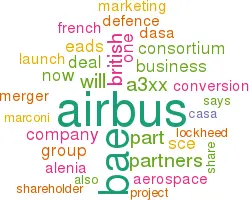What does EADS mean for Airbus and the A3XX?
November 1999


Just as the merger between British Aerospace and the Marconi defence electronics group sent a series of aftershocks through the global aerospace industry, so one of the biggest of those aftershocks — the merger of Aerospatiale Matra and DASA (the aerospace part of DaimlerChrysler) — is itself causing tremors.
The French–German merger, which gives birth to the European Aeronautics, Space and Defence Systems company (EADS), came about because BAe last year abandoned a deal with DASA in favour of a domestic British deal with Marconi, creating an integrated group covering both defence electronics and the aerial platforms they go on.
In the longer term, the major effect will be to spur both BAe and EADS to find transatlantic alliance partners; BAe historically was close to McDonnell Douglas, but chose to ally with Lockheed Martin in its bid for the Pentagon fighter mega–contract, for fear of upsetting its European Airbus partners. But now that Lockheed is in trouble and the French and Germans are getting tougher without the British, some BAe executives wish they had gone with the winning Boeing team rather than Lockheed.
GIE to SCE
The immediate impact, however, of the Franco–German deal will be on the future of Airbus. For years discussions about converting this GIE (Groupement d'Interet Economique) from a loose consortium into a proper company (the SCE or Single Corporate Entity) have got bogged down in squabbles over valuations of the assets devoted to Airbus by the four partners- Aerospatiale–Matra, DASA, British Aerospace and CASA. But assimilation of CASA by DASA and the Aerospatiale–DASA should simplify things. As one BAe executive says, "We are now only one negotiation away from creating a single corporate entity for Airbus". Between them the French and the Germans (including CASA) now own about 80% of Airbus, but BAe still enjoys a veto over important decisions, such as whether to admit an eager Lockheed Martin to some of its projects.
BAe is keen to proceed with the conversion for several reasons. The business reasons start with the benefits the change will bring to Airbus, by increasing stock–turns and generally improving efficiency, bringing benefits of at least $1bn a year. Conversion will also make it easier to raise money from governments, from banks and from other risk–sharing partners in order to finance the $11bn development of the A3XX .
Importantly, an Airbus SCE will help to crystallise the shareholder value which BAe estimates is tied up in the consortium arrangement. Mike Turner, BAe’s executive director in overall charge of its Airbus interests reckons that today’s valuation of £2bn ($3.2bn) on its Airbus share could be worth twice that amount in four years, after conversion to an SCE. BAe has rejected the option of selling out of Airbus in favour of holding in for the long term to realise full shareholder value, when Airbus is eventually floated after conversion.
There are still hurdles to be overcome. For instance, BAe believes that the work it does on Airbus is worth more than the 20% share it has of the development, marketing and product support consortium. Even so, things should be simpler. "In the past," says a BAe insider, "we were talking about selling a part of our company to three other companies in return for buying a small part of each of theirs. Now we are just swapping a part of our company for something hopefully more than 20% of the Airbus company."
SCE pre-condition to A3XX
Simpler the negotiations may be, but they could not be more urgent. Although no one formally says so, the SCE is a pre–condition to the production launch of the A3XX.
Neither the British nor the German government wants to pour money into what may be an ill–defined black hole. Moreover, there is always the suspicion of job–protection engendered by the French government involvement in the project.
Beyond such concerns, Airbus is trying to raise capital for the project on a risk–sharing basis from suppliers and airlines; both would be happier if it were housed in a transparent company rather than a consortium where the core partners can hide all sorts of nasty numbers.
Soon the supervisory board will authorise CEO Noel Forgeard and his marketing team to go out and make offers to airlines in the hope of landing two or three launch customers, preferably including those prepared to share part of the risk.
Buteven this marketing launch does not signal the definitive go–ahead for the A3XX project. In fact, the marketing launch is really part of the iterative process of putting together the business case for the aircraft. The stronger the market prospect, the better the business case.
Defensive manoeuvres
Airbus makes up about half the business of EADS. But the defence side of both also involves a complex set of working relationships. BAe calculates that, counting in Airbus, about 70% of EADS’s business is tied up in joint ventures in which it is involved. For example, in missiles, the activities of BAe, Matra, Aerospatiale and those of the Italian group Alenia are all in one group now, thanks to BAe’s merger with Marconi, the formation of EADS and a new agreement between BAe and Alenia. Only the partly privatised French group Thomson remains outside this Euromissile grouping, which is number two in the world to America’s Raytheon.
BAe is also trying to tie up a new deal with Alenia on aircraft, so that the British- Italian couple could be the dominant partners in the Eurofighter consortium. The attraction for Alenia is that such a deal could open the door to its entry into Airbus, primarily as a risk–bearing partner in the A3XX but later as a full shareholder. Indeed it is a reflection of Airbus’s recent sales success that outsiders are queuing up to join.